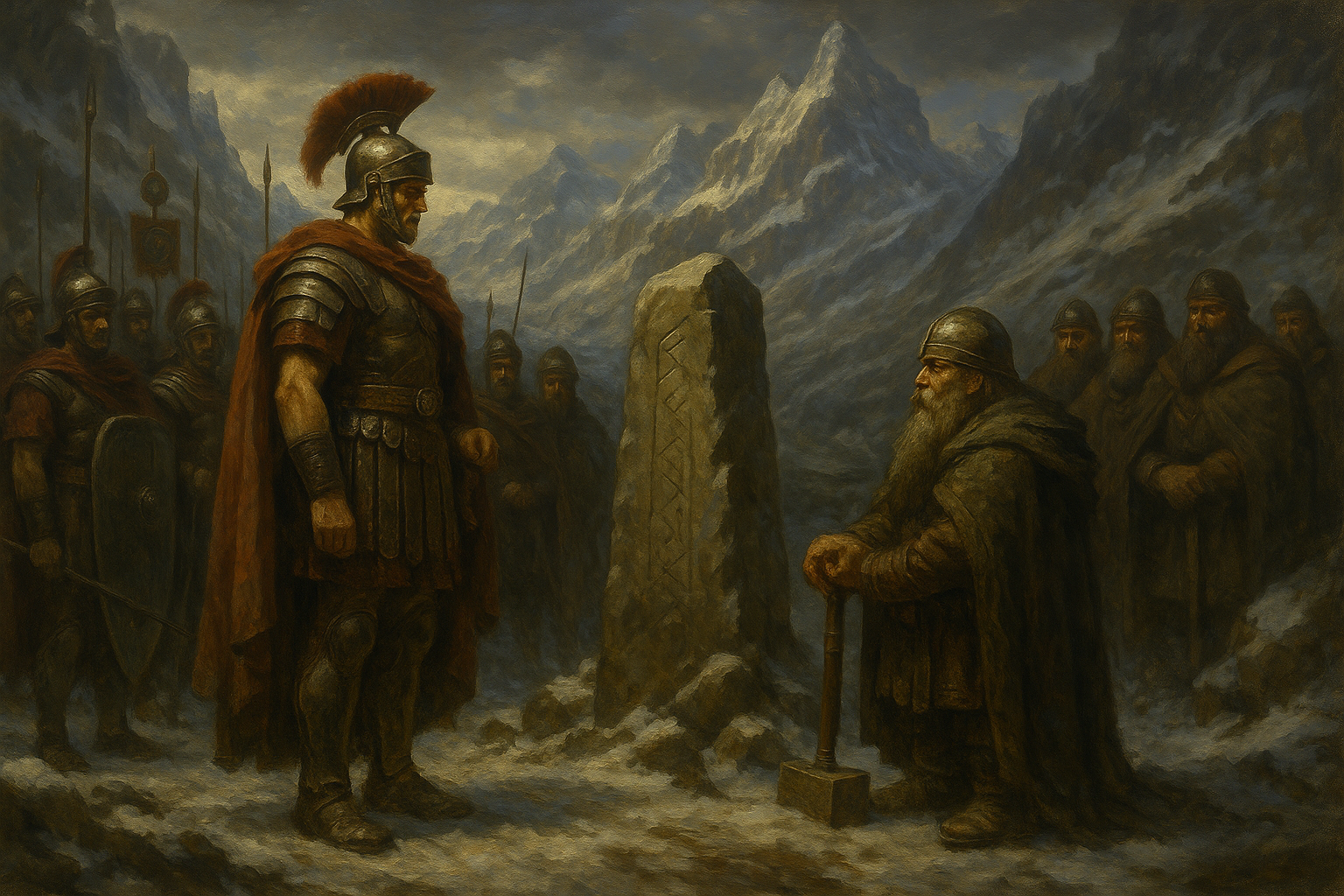The Ashfang Campaign
“They called it a campaign; we called it a siege of the soul. And in the end, the mountain endured.”
The Ashfang Campaign began with arrogance disguised as ambition. In the spring of 68 AR, the Empire, emboldened by successive victories on other fronts, declared its intent to “pacify and civilize” the Ashfang Range. Officially, the campaign was justified as a mission to secure crucial mineral wealth for the rebuilding of Nova Roma after earlier Rift disturbances. Unofficially, it was driven by greed and the desire to break the dwarves’ stubborn independence — a thorn in the Empire’s pride for decades.
At the outset, the dwarves were fractured: a patchwork of proud but quarrelsome clans, each guarding its own halls and valleys. Imperial spies assured the Senate that such a divided people could not resist for long. But as Imperial soldiers began to occupy lowland villages and drive ever deeper into the mountains, a slow but steady unification began among the dwarves. Clan meetings turned into councils; councils became conclaves. In a cavern deep beneath Mount Targaleth, the Stone Assembly was born — and with it, the resolve to resist.
The Conflict
Prelude
The Ashfang Campaign began with arrogance disguised as ambition. In the spring of 68 AR, the Empire, emboldened by successive victories on other fronts, declared its intent to “pacify and civilize” the Ashfang Range. Officially, the campaign was justified as a mission to secure crucial mineral wealth for the rebuilding of Nova Roma after earlier Rift disturbances. Unofficially, it was driven by greed and the desire to break the dwarves’ stubborn independence — a thorn in the Empire’s pride for decades.
At the outset, the dwarves were fractured: a patchwork of proud but quarrelsome clans, each guarding its own halls and valleys. Imperial spies assured the Senate that such a divided people could not resist for long. But as Imperial soldiers began to occupy lowland villages and drive ever deeper into the mountains, a slow but steady unification began among the dwarves. Clan meetings turned into councils; councils became conclaves. In a cavern deep beneath Mount Targaleth, the Stone Assembly was born — and with it, the resolve to resist.
Deployment
The Empire committed three full legions — the Third, Seventh, and Ninth — to the Ashfang Campaign, supported by auxiliary cavalry, engineers, and vast supply trains of mules and porters. Massive siege engines were hauled into the mountains at great cost. Imperial generals believed a swift strike into the heart of the Ashfang would break the dwarves’ will before winter.
Meanwhile, the dwarves summoned every able-bodied fighter, miners became sappers, and smiths forged weapons in secret forges. Women and children carried supplies and dug tunnels. Clans carved hidden pathways, booby-trapped mountain passes, and converted every cave into a redoubt. While the Empire brought numbers and discipline, the dwarves brought knowledge of every crack, ledge, and hiding place in the mountains.
Battlefield
The Ashfang Range itself was both shield and sword for the dwarves. Its narrow valleys, sheer cliffs, and maze of tunnels turned every advance into a perilous climb, every retreat into a deadly descent. Ravines and icy stairways became battlefields; bridges collapsed under marching Imperial columns. Hidden caves allowed the dwarves to appear seemingly from nowhere, strike, and vanish.
The final confrontation, the Winter of Spears, took place on Mount Targaleth itself — where snow and wind conspired with the defenders to turn the ascent into a slaughter.
Conditions
The mountains punished the invaders. Bitter cold froze fingers to sword hilts and shattered wheels on supply wagons. Avalanches triggered by the dwarves crushed entire companies. Tunnels collapsed under the feet of Imperial engineers. Starvation and disease festered in the Imperial camps, whose supplies could not keep up with the terrain. Dwarves, acclimated and prepared, endured with grim determination — but even they lost many to exposure and frostbite.
The Engagement
Over fourteen years, the campaign became a war of attrition, with neither side able to secure total victory. The Empire pressed ever upward, seizing and holding valleys only to be harried into withdrawal by night raids and rockslides. Skirmishes bled into sieges; sieges bled into massacres.
The defining engagement — the Winter of Spears — came in the 14th year. The Imperial High General ordered a final, desperate push to take the summit of Mount Targaleth and shatter the dwarves’ spirit once and for all. His forces climbed through howling blizzards, only to find themselves ambushed, encircled, and driven into ravines. Entire cohorts were buried under snow. Cornered and broken, the general sued for peace atop the summit.
Outcome
Imperial forces withdrew, trade routes reopened under dwarven terms, and the Stone Assembly became the sole governing body of the Ashfang.
Aftermath
The Empire retreated from the Ashfang Range and formally acknowledged the Stone Assembly as the governing body of the dwarves. Trade between the two peoples resumed under dwarven terms. While mutual suspicion persisted, both sides honored the Concord for centuries. The dwarves emerged unified and proud, their clans forever bound by the memory of shared struggle.
Historical Significance
The Ashfang Campaign permanently reshaped the political landscape of the northern Empire. For the dwarves, it marked the birth of national identity and the legitimization of the Stone Assembly. For the Empire, it was a bitter lesson in the limits of its reach — proof that even its mightiest legions could be humbled by a determined foe and hostile terrain.
Legacy
To the dwarves, the campaign is immortalized as a saga of endurance and sacrifice. Annual festivals on the Concord’s anniversary retell its stories in song and stone. The mountain passes still bear names like “Speargap” and “Widow’s Climb,” and the Concord Stone remains the centerpiece of dwarven pride. In Imperial military academies, the Ashfang Campaign is taught as a cautionary tale of hubris, logistics failure, and underestimating the enemy.
In Literature
The dwarves’ Saga of the Winter Spears is a 3,000-line epic inscribed in the Halls of Tharindel, recounting the campaign in heroic verse. Imperial poets have written both mournful laments for the fallen legions and romanticized tales of doomed glory. Popular plays among the Riftborn and even humans sometimes depict the tragic figure of High General Lucius Veran in his final parley.
Technological Advancement
The dwarves refined techniques in avalanche triggering, subterranean logistics, and rock fortification, innovations still used today. They also developed improved cold-weather gear and emergency signaling methods. The Empire, in turn, improved its alpine engineering, supply line security, and adapted certain dwarven techniques for its own mountain campaigns.




Comments